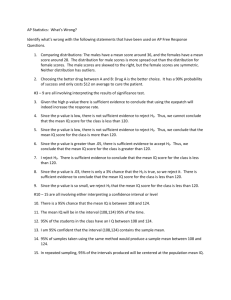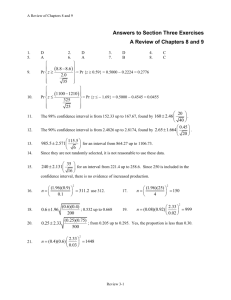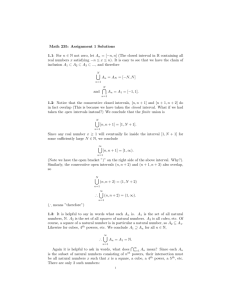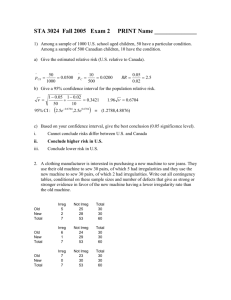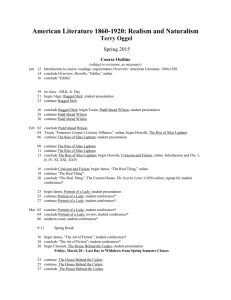Key2PS5
advertisement
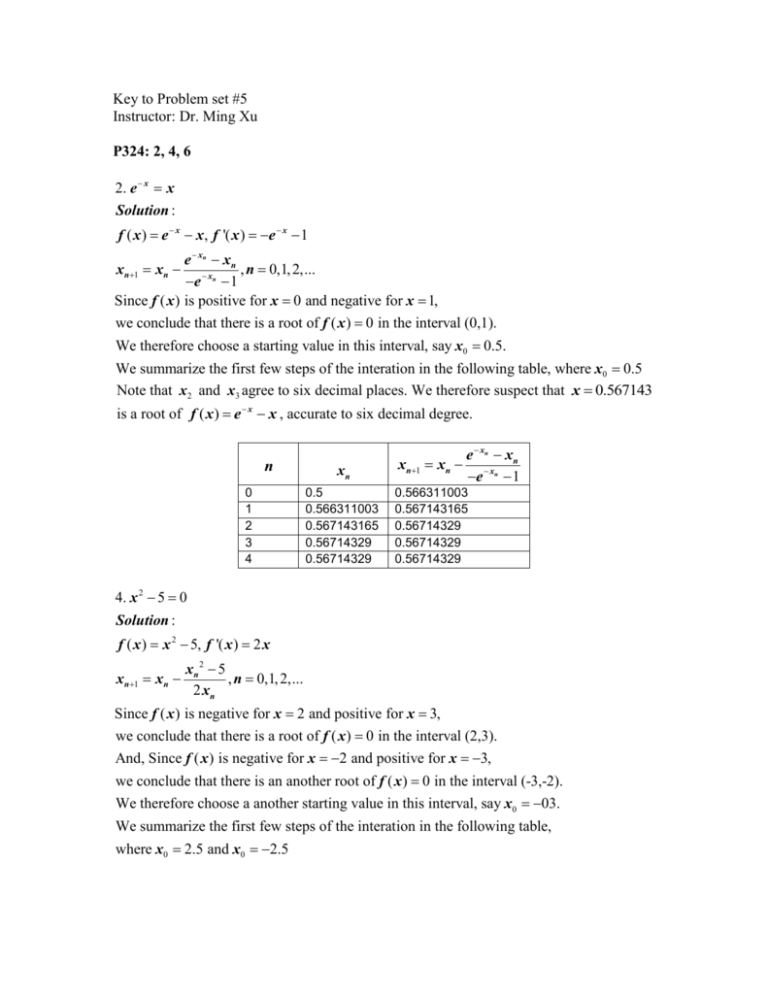
Key to Problem set #5 Instructor: Dr. Ming Xu P324: 2, 4, 6 2. e x x Solution : f ( x ) e x x , f '( x ) e x 1 e xn x n , n 0,1, 2,... e xn 1 Since f ( x ) is positive for x 0 and negative for x 1, we conclude that there is a root of f ( x ) 0 in the interval (0,1). We therefore choose a starting value in this interval, say x0 0.5. xn1 xn We summarize the first few steps of the interation in the following table, where x0 0.5 Note that x2 and x3 agree to six decimal places. We therefore suspect that x 0.567143 is a root of f ( x ) e x x , accurate to six decimal degree. n 0 1 2 3 4 e xn x n e xn 1 xn xn1 xn 0.5 0.566311003 0.567143165 0.56714329 0.56714329 0.566311003 0.567143165 0.56714329 0.56714329 0.56714329 4. x 2 5 0 Solution : f ( x ) x 2 5, f '( x ) 2 x xn 2 5 xn1 xn , n 0,1, 2,... 2 xn Since f ( x ) is negative for x 2 and positive for x 3, we conclude that there is a root of f ( x ) 0 in the interval (2,3). And, Since f ( x ) is negative for x 2 and positive for x 3, we conclude that there is an another root of f ( x ) 0 in the interval (-3,-2). We therefore choose a another starting value in this interval, say x0 03. We summarize the first few steps of the interation in the following table, where x0 2.5 and x0 2.5 Note that x3 and x4 agree to seven decimal places. We therefore suspect that x1 2.2360679, x2 2.2360679 are two roots of f ( x ) x 2 5 xn 2 5 xn1 xn 2 xn xn 0 1 2 3 4 5 2.5 2.25 2.236111111 2.236067978 2.236067977 2.236067977 2.25 2.236111111 2.236067978 2.236067977 2.236067977 2.236067977 xn 2 5 xn1 xn 2 xn xn -2.5 -2.25 -2.236111111 -2.236067978 -2.236067977 -2.236067977 -2.25 -2.236111111 -2.236067978 -2.236067977 -2.236067977 -2.236067977 6. (a) Solution: 1 f '( x ) , for x 1 2 x 1 1 = , for x 1 2 1-x We find f ( xn ) xn1 xn f '( xn ) xn 2 xn 1( xn 1), for x 1 = xn 2 1 xn ( 1 xn ), for x 1 = - xn 2 for xn1 If x0 1 h, then x1 1 h, x2 1 h, x3 1 h, and so on; that is, successive approximations oscillate between 1 h and 1- h, and never approach the x 1. (b) No, it doesn’t converge since that tangent line at x 1 h is parallel to the tangent line at x 1 h . 3 2 1 0 -3 -1 -2 -3 -2 -1 0 1 2 3 4 5 8. (a) Solution: We can sovle the roots of x 4 x 2 0 . Since x 4 x 2 x 2 ( x 1)( x 1), there are three 1 2 , successive values are collected in the roots: r 0, r 1, r 1. If we set x0 2 following list: X0 X1 X2 X3 X4 X5 X6 X7 X8 X9 X10 -0.707106781 -7.96131E+14 -5.97099E+14 -4.47824E+14 -3.35868E+14 -2.51901E+14 -1.88926E+14 -1.41694E+14 -1.06271E+14 -7.9703E+13 -5.97773E+13 We can conclude the method converges to the root x 1 , but the speed is very slow. 14 12 10 8 6 4 2 0 -2 -2 -1.5 -1 -0.5 0 (b) Set x0 0.71 , we get the following list: X0 X1 X2 X3 X4 X5 X6 X7 X8 X9 X10 X11 X12 X13 X14 X15 X16 -0.71 -22.17884146 -16.63977283 -12.48735534 -9.37555883 -7.045077933 -5.301731893 -4.000303115 -3.032482799 -2.317952537 -1.797924648 -1.430689731 -1.188628731 -1.054237065 -1.006209742 -1.000094409 -1.000000022 0.5 1 1.5 2 We can conclude the method converges to the root x 1 . But the converging rate is slower than the speed in example 5. Set x0 0.6 , we get the following list: X0 X1 X2 X3 X4 X5 X6 X7 X8 X9 X10 -0.6 0.085714286 0.042537578 0.021230165 0.010610294 0.005304549 0.0026522 0.001326091 0.000663044 0.000331522 0.000165761 We can conclude the method converges to the root x 0 . That is to say, given different initial value for a function with multiple roots, Newton-Raphson method will converge to different root with different converging speed. 10. Solution: We use the function of last question and set x0 1 , and get the following list: X0 X1 X2 X3 X4 X5 X6 X7 X8 X9 X10 1 1 1 1 1 1 1 1 1 1 1 14 12 10 8 6 4 2 0 -2 -2 -4 -6 -8 -1.5 -1 -0.5 0 0.5 1 1.5 2 We can conclude that the subsequent iterations are all x 0 . x 0 =1 is the only point that the tangent line intersected with the function graph. Additional Question: y bx Solution: xi yi 159104.1 8.48 , so the function is y 8.48 x b 2 xi 18762.77 2 i xi y i xi yi xi 1 2 3 4 5 6 7 8 9 10 11 12 13 14 15 16 17 18 sum 27.2 35.6 37.9 31.3 32.6 36.4 29.8 34 32.3 27.9 29.1 36.2 33.3 28.1 30.2 35.8 32.7 27.7 147 371 428 246 255 370 215 299 274 161 170 361 300 188 215 366 264 172 3998.4 13207.6 16221.2 7699.8 8313 13468 6407 10166 8850.2 4491.9 4947 13068.2 9990 5282.8 6493 13102.8 8632.8 4764.4 159104.1 739.84 1267.36 1436.41 979.69 1062.76 1324.96 888.04 1156 1043.29 778.41 846.81 1310.44 1108.89 789.61 912.04 1281.64 1069.29 767.29 18762.77





